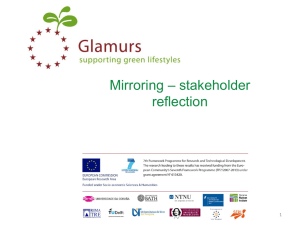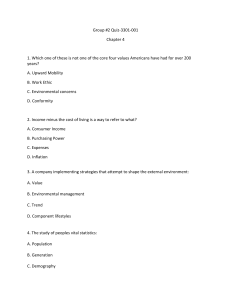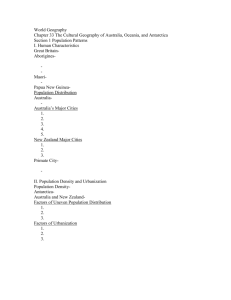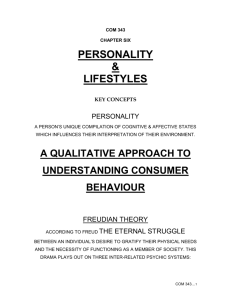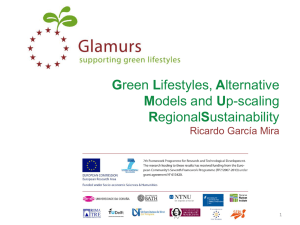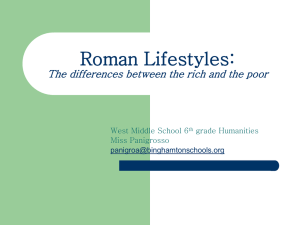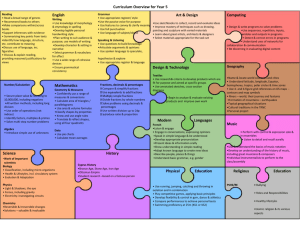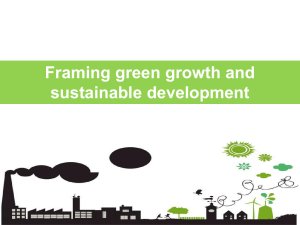Document 10465372
advertisement
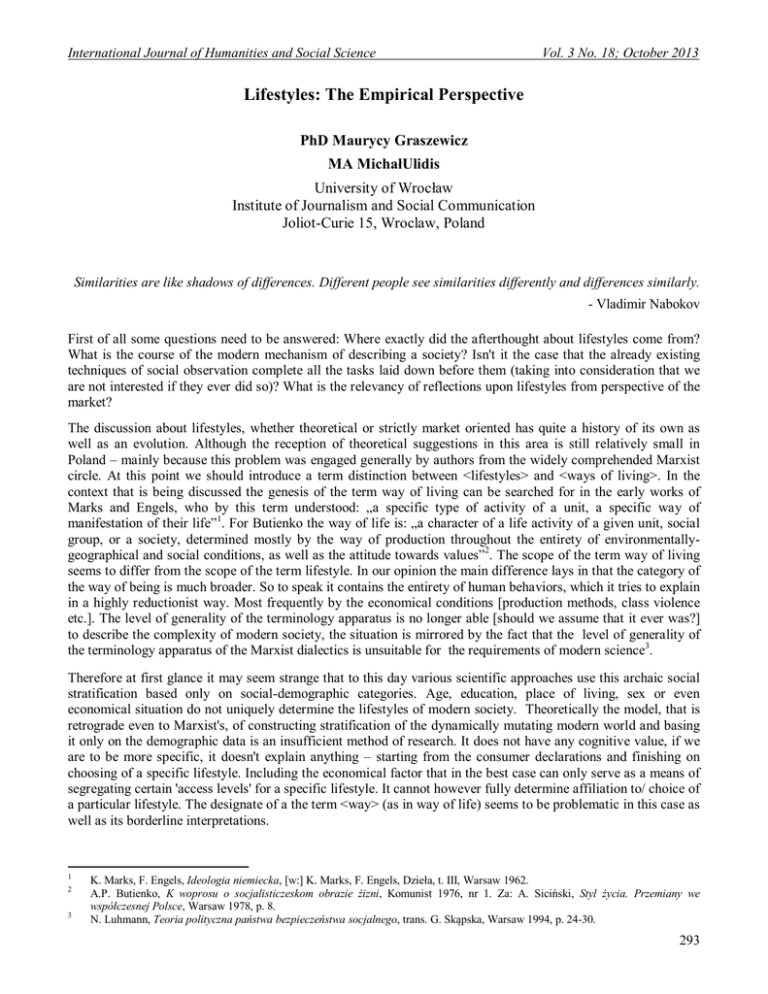
International Journal of Humanities and Social Science Vol. 3 No. 18; October 2013 Lifestyles: The Empirical Perspective PhD Maurycy Graszewicz MA MichałUlidis University of Wrocław Institute of Journalism and Social Communication Joliot-Curie 15, Wroclaw, Poland Similarities are like shadows of differences. Different people see similarities differently and differences similarly. - Vladimir Nabokov First of all some questions need to be answered: Where exactly did the afterthought about lifestyles come from? What is the course of the modern mechanism of describing a society? Isn't it the case that the already existing techniques of social observation complete all the tasks laid down before them (taking into consideration that we are not interested if they ever did so)? What is the relevancy of reflections upon lifestyles from perspective of the market? The discussion about lifestyles, whether theoretical or strictly market oriented has quite a history of its own as well as an evolution. Although the reception of theoretical suggestions in this area is still relatively small in Poland – mainly because this problem was engaged generally by authors from the widely comprehended Marxist circle. At this point we should introduce a term distinction between <lifestyles> and <ways of living>. In the context that is being discussed the genesis of the term way of living can be searched for in the early works of Marks and Engels, who by this term understood: „a specific type of activity of a unit, a specific way of manifestation of their life”1. For Butienko the way of life is: „a character of a life activity of a given unit, social group, or a society, determined mostly by the way of production throughout the entirety of environmentallygeographical and social conditions, as well as the attitude towards values”2. The scope of the term way of living seems to differ from the scope of the term lifestyle. In our opinion the main difference lays in that the category of the way of being is much broader. So to speak it contains the entirety of human behaviors, which it tries to explain in a highly reductionist way. Most frequently by the economical conditions [production methods, class violence etc.]. The level of generality of the terminology apparatus is no longer able [should we assume that it ever was?] to describe the complexity of modern society, the situation is mirrored by the fact that the level of generality of the terminology apparatus of the Marxist dialectics is unsuitable for the requirements of modern science3. Therefore at first glance it may seem strange that to this day various scientific approaches use this archaic social stratification based only on social-demographic categories. Age, education, place of living, sex or even economical situation do not uniquely determine the lifestyles of modern society. Theoretically the model, that is retrograde even to Marxist's, of constructing stratification of the dynamically mutating modern world and basing it only on the demographic data is an insufficient method of research. It does not have any cognitive value, if we are to be more specific, it doesn't explain anything – starting from the consumer declarations and finishing on choosing of a specific lifestyle. Including the economical factor that in the best case can only serve as a means of segregating certain 'access levels' for a specific lifestyle. It cannot however fully determine affiliation to/ choice of a particular lifestyle. The designate of a the term <way> (as in way of life) seems to be problematic in this case as well as its borderline interpretations. 1 2 3 K. Marks, F. Engels, Ideologia niemiecka, [w:] K. Marks, F. Engels, Dzieła, t. III, Warsaw 1962. A.P. Butienko, K woprosu o socjalisticzeskom obrazie żizni, Komunist 1976, nr 1. Za: A. Siciński, Styl życia. Przemiany we współczesnej Polsce, Warsaw 1978, p. 8. N. Luhmann, Teoria polityczna państwa bezpieczeństwa socjalnego, trans. G. Skąpska, Warsaw 1994, p. 24-30. 293 © Center for Promoting Ideas, USA www.ijhssnet.com Through the way of life we can also grasp the meaning of Siciński's „behavioral characteristics of behaviors”, against which he places the conception of lifestyle, understood as a series of behaviors, that are differentiated as to the scope and form, set for a specific aim – „activities” and „actions” of a unit as well as a the values and meanings attributed to it - „motivations” together with results and instruments of those actions 4. It should be stipulated that as a base of his so called ‘cognitive conception’ of lifestyles AndrzejSiciński takes away the free choice that any unit is equipped with - „the objective terms of alternative behaviors and awareness of the presence of this alternative”5. In the thought postulated by the homo eligens6 concept, the choice is made from the offers of the cultural system, and the lifestyle itself is defined as „an indication of a some rule of everyday choice of actions from a range of behaviors possible for a given culture”7. This methodological perspective is not oriented only towards specific human behaviors, it rather searches for exemplar behaviors based on the rule of an aware and undetermined choice as well as the values and meanings following it. However we still don't know which of behaviors to classify as relevant for distinguishing such exemplar models. Moreover we don't know which of the behaviors, as we can only access them through observation, can be classified as undetermined and natural – completely free? Many scholars see Alfred Adler – father of individual psychology – as the creator of the term <lifestyle>. On the other hand one of the first to use this term in order to describe dynamical processes taking place in the rapidly changing global society of the capitalistic age was the pioneer of the neo-evolutionary reflections over the so called post-industrial society, Alvin Toffler. Among the overabundance of historical reflections on lifestyles form our point of view the most interesting concepts seem to be those of deriving from sociology. Of course it is necessary to remember that the term itself has a very rich history in the psychological tradition as well, an example of which are the conceptions of creating a typology of consumers based on the psychographic segmentation. Psychographic research in general words is determining the personality traits8 of a given person or a group. Most frequently those psychological profiles are reconstructed using the quantity methods, mainly by using all kinds of scaling. Respondents are asked to determine themselves through scales that are provided by the authors of a given research. Psychometric tests are based on a simmilar mechanism9, used for measuring the individual differences. In both of the above mentioned cases the data received [disregarding the psychological approach] need, in our opinion, to be complemented by for example the quality method. It arises from the simple fact that it's hard to point out a strict connection between character/personality profiles of consumers and the choices they make [not only consumer related choices]10, the consequence of which is their choice of a lifestyle. The psychographic segmentation is often criticized for its rather small and often non synonymous heuristic potential regarding the behavior of researched groups11. Although for our discussion the imperfectness of this method seems to be the fact that it is conceived as a way for interpreting consumers behaviors12. The category of personality seems to be problematic as well, in the light of constructivism it has a constructive character itself. We could speak about a one inalienable and objective personality but it would be to no purpose. On the empirical level we operate rather on the distinction between a self-construct of a person or a group and sets of cognitive constructs [of his/hers] personality, which are relative to certain variables like a group of respondents, time or even place of the research. A possible solution from this impasse might be supplementation of the research material with for example observations of respondents' houses 13 and photographic documentation. It's hard not to mention another serious problem arising at this point. We think that the lifestyles are subjected to empirical influence over time, in a longer perspective. However if we look at the newer and older history of Poland we see changes that can be called radical. Grasping the structures of communication, realization of offers that might be included in the lifestyle seems to be hard. The easiest way out of this problem is to set up lifestyles in an arbitrary way and try to find a confirmation for them in the empiric. Karl Popper'sdoctrine come with aid in this situation. 4 5 6 7 8 9 10 11 12 13 294 A. Siciński, Styl życia, kultura, wybór – szkice, Warsaw 2002, p. 21-23. Ibidem. Etymology: [lat.] eligo, eligere - to choose. A. Siciński, Styl życia, kultura, wybór, p. 26. Understood as psychological properties. University of Sunderland, Psychometric testing policy, Sunderland 2006, p. 2. S. Ahlm, M. Holmström, V. Stenman, Traditional market segmentation – an evaluating approach, Lund 2007. D. Yankelovich. D. Meer, Rediscovering Market Segmentation, [w:] Harvard Business Review, 2006, no 84, p. 122-131. C.M. Morgan, D.J. Levy, M. Fortin, Psychographic Segmentation, [w:] Communication World 2003, no 22, p. 22 Zob. S. Ahlm, M. Holmström, V. Stenman, Traditional market segmentation, p. 41. International Journal of Humanities and Social Science Vol. 3 No. 18; October 2013 We think that in this case any assumption simply cannot be made. The search for a model, a reproduction of the network of connections between certain factors of lifestyles and even the choice of such factors [for example the way of spending free time, attitude towards work, the time between] is in this case much harder [or maybe much easier] because by not making assumptions we don't know if the elements that we simply cannot see exist.As far as the sociologically oriented origin of the discussed problem of lifestyle is concerned it is enough to cite, what will be discussed in more details later on in this article, the words of Max Weber who pointed out that „the social differences throughout lifestyles are not so much dependent on production as on consumption” 14. The logic of this statement forces us to briefly describe the current theories of describing a society and the differences occurring while in comparison with earlier theories. The axis for the new theories of discretion of the society, that also explain its inner mechanism of differentiation and functioning, is underlining the theory of communication as a basis for the description. Society is an "open, autoreflective and autoreferential system (...). Modern society can be perceived as a dynamic development from stratification to functional differentiation"15. The basic material of that what's social are not people but interpersonal communication. Society should be understood as an imperative system regulating all possible communicative configurations between individuals. Social system in itself focuses on functions. It means that social system consists of functional subsystems (politics, economy, religion, science, education, family or healthcare) each one of which constitutes itself in the scope of internal, specific functions which are performed in the society. And so, for example, the code of the "law" subsystem is differentiation between "legal" and "illegal," the code of the "science" subsystem differentiates between "true" and "false," in the case of "mass media" system: "information" and "lack of information," in "politics:" "government" and "lack of government 16. Therefore everything what is a communication, is also a society. This is a key statement. Communication is a material of what is social. It allows the society to reproduce in its interconnections. In other words the focus on the description of social structure and its parts (social groups, classes) and resulting stratification (eg. demography) was replaced with focus on functions and the means to describe are no longer adequate. It also means an incomparably bigger complexity of formation functionally differentiated above the class structure. It is no more useful to comment the clash of class description of society in which the place of birth determined the future life of every individual and class defined the rhythm and way of life. Furthermore the pattern of life described multi-phased way of the entire life of the huge social group member17. Shoemaker's son would most frequently become a shoemaker himself, a farmer's son would become a farmer and only an aristocrat's son would pursue education, graduate from universities and furthermore gained greater communicative competence as well as knowledge of the world around him. That what was available for one person, was not for the other. In a society focused on functions the life patterns democratized itself and everyone (to a certain degreecan become what they want18. Let's get back to this description for a moment since a keen observer will notice another life pattern common to a certain degree for the daughters of shoemakers, farmers and aristocrats. Creating the population model based upon demographical data (sex, age, education, place of residence plus data pertaining to occupation or income) is based upon a regressive theory of class or hierarchical divisions. In a certain manner such data allowed to describe a social structure and specified variables correlated with each other. Lets get back for a moment to a previous description of life pattern. Which sex was better educated in that times?19 How did education correlate with a place of residence? How did income relate to eg. age or education? 14 15 16 17 18 19 A. Ostrowska, Styl życia, a zdrowie, Warsaw 1999, p. 16. M. Graszewicz, Polski system polityczny. Semantyki i struktury komunikacji politycznej, Wrocław 2012, p. 53. Por. Luhmann N., Polityka państwa bezpieczeństwa socjalnego, Warszawa 1996, p. 25-32; Luhmann N., Systemy społeczne: zarys ogólnej teorii, Warszawa 2007, p. 380-381; Luhmann N., Realność mass-mediów, Wrocław 2009,;Graszewicz M., Polski system polityczny. Semantyki i struktury komunikacji politycznej, Wrocław 2012, p. 40-60; D. Lewiński, "Konstruktywistyczne koncepcje komunikacji" [w]: „Oblicza komunikacji 1. Perspektywy badań nad tekstem, dyskursem i komunikacją”, Kraków 2006; „Edukacja a media” (together with Mark Graszewicz) [w]: „U progu wielkiej zmiany? Media w kulturze XXI wieku. Nurty - kategorie - idee”, Kastylia., Olsztyn 2005. Hajduk E., Kulturowe wyznaczniki biegu życia, Warszawa 2001, p. 30-32. Its enough to say that the schooling level in the school year 2008/2009 of higher education schools was 53% in Poland (from RocznikStatystykiMiędzynarodowej 2012, GłównyUrządStatystyczny, Warszawa 2012 r.) A traditional woman’s biography was connected rather with a transaction (because surely not with the choice – the concept of dowry) of being married also because working (at least the one that was paid for) was very scarse in woman's biographies while being married gave a promise of subsistence. 295 © Center for Promoting Ideas, USA www.ijhssnet.com In a class society, as Luhmann describes "every person (or every family to be specific) belonged to one and only one social class. Such person was defined by her class which placed them in the social structure, showed them the place in the society. This pattern of social differentiation differentiated and determined the man as a social construct."20. social classes cease to fill their members with collective identities and habitues related to them (of a worker, a farmer or an intellectual). God, honor or nation are no longer essential for increasing number of Poles. More and more people describe themselves by their lifestyles, they would describe themselves as, for instance, followers of ecological trends, they would use personality traits, ways of spending free time, favorite music or preferences to differentiate themselves from others21. The speed of social changes, increasing differentiation of society, consumerism being the part of identity industry (explanation further in the text) or social metacommunication thanks to mass media system results in the earlier types of stratification being at least not precise in a modern society, if not entirely false in nature. What is interesting from this point of view is the mechanism of moving from the industrial to consumeristiccapitalistic society subject to volatile fluctuations. What is the current correlation between education and place of residence? Or between education and sex (nowadays statistically women are better educated than men)? Finally how can we explain, using regressive theory and connected with it demographical description of society, the fact that in a modern society life patterns are not the result of a place (also in a class sense) of birth and theoretically everyone can become what they desire to become? Before we answer the question it has to be clarified what is the origin of reflection pertaining to lifestyles. In function-oriented societies the rules of belonging are being replaced by the rules of accessibility and possibility. The place of individuals in a social structure, as mentioned before, is not related to the place of birth. In highly complex societies, in which politics and religion are not the only institutions fighting for domination and economy along with mass media system became the dominant systems we observe an essential shift of social stratification factors. To be precise, the offers, from which an individual can choose, differentiate. Lifestyles therefore become choices from an array of communicative offers combining groups of similar values and cognitive views. Reflections pertaining to lifestyles are most fully described by the logic of consumeristic capitalistic society. What does it mean? To better explain changes taking place we have to state that we deal with a series of overlapping factors generating the changes. From one hand it is the logic of economy introducing everything that can be introduced to the free market 22. On the other, economical processes, ie. homogenization and production popularization are in motion (you can buy Coca-Cola in most countries of the world and floor panel of the Seat Ibiza car is no different from the one in Skoda Fabia or Volswagen Golf.) Lasting increase of the economical dynamics connects with the increase in homogenization and internalization of products, services, preferences and markets. Most of the "blind trials"23 show that people being asked don't recognize the differences between mineral waters, popular coke-flavored drinks, wines or brands of chocolate. According to the test of 13 anti-wrinkle creams conducted by a specialist laboratory for Polish Pro-Test foundation it is clear that female consumers are unable to notice any significant difference in the products24. We can observe a similar pattern in all businesses, eg. in motorization where similarly priced cars have similar features eg. ABS, ESP or airbags; not many people know that a lot of Samsung chipsets are used in many Apple products. So which car brand or computer manufacturer is the best? Depends on the customer 25.Economy is also characterized by the huge oversupply and the law of supply and demand from the "external" point of view has ceased to explain internal economical processes. Therefore the answer to the question "Satisfaction or creation of demand?" is without a doubt "creation." 20 21 22 Luhmann N., Teoria polityczna państwa bezpieczeństwa socjalnego, Warsaw 1994, p. 37. Graszewicz M., Ulidis M., Style życia. Zarys systemowej teorii i koncepcji badawczej, [w:] Dziennikarstwo i Media 2, "Kształtowanie wizerunku jako narzędzie public relations" (ed.) Igor Borkowski, Karina Stasiuk-Krajewska, Wrocław 2011. Por. N. Luhmann, Systemy społeczne. Zarys ogólnej teorii, Warszawa 2012; Wizerunek Uniwersytetu Wrocławskiego. Aspekt teoretyczny (razem z Dominikiem Lewińskim), [w:] Wizerunek Uniwersytetu Wrocławskiego w oczach studentów studiów stacjonarnych (red.) Maurycy Graszewicz, Dominik Lewiński, Karina StasiukKrajewska, Wrocław 2012. 23 Blind test is an evaluation of coded trials without prior knowledge of the brand. It aims at eliminating external factors falsifying the evaluation such as being used to the brand, knowing it, the container quality etc. 24 http://www.protest.pl/tests_article/60995,0/Test+krem%C3%B3w+przeciwzmarszczkowych+pod+oczy_Cud%C3%B3w+nie+ma.html [access: 04.05.2013.] 25 ZarządzanieDesignem (together with MichałUlidis), AIRGATE – Kraków Airport Magazine, No 6, 2012. 296 International Journal of Humanities and Social Science Vol. 3 No. 18; October 2013 If economy was to deal only with satisfying demand it would be difficult to explain a plethora from the same perspective that "the need of moving from point A to point B" can be fully met by the old cars and the need to get dressed - by the same set of clothing like in, eg. North Korea. In the modern world "one of the most frequent visions helping to explain the order of life content is putting them in a circle and putting "I" in the center of said circle26. There is a certain relation modus between the aforementioned "I" and the things, people, ideas, businesses that we can describe only as a distance between them"27. In order to underline the difference we have to remember that a class-based society relied on the fact that the members of one class looked more or less alike. The matter of individualism is therefore a matter of "constructing" individualism through consumerism. How should the modern "I" construct their identity if the formula of a country, nation, religion that used to help in said construction, is ceasing to exist? As Holt says "In the modern society the traditional sources of cultural expression, religion, nation, art, education and other institutions, are mostly dominated by mass media and commercialism. Since the beginning of the 20th century the western companies were competing in turning this rich source of economical value into profit. This they became the main commercial source of cultural message. Hence the markets for cultural messages are, by definition, much wider than traditional product markets."28. In the passing phase brands served as a distinguishing tool and "branded products" divided society into classes. It is enough to remember Coca-Cola cans standing on the shelves in certain apartments when the drink was not widely available, Levi's trousers or Pewex shops. Today, when all the products are branded, using them is regulated (apart from the "money for value" calculation) not by the product features (hence, but also due to functional equivalence the USP formula has ceased to exist)29, or its physical propertiesbut by the pleasure principle and the rule of identity. Thanks to the brands we gain the ability to differentiate ourselves from others and by using them we can manifest our belonging to something (ideology, group, etc.), equip ourselves and fulfill our desires (eg. by partaking in the WWF or Amnesty International brand) or, finally, show our social status and construct as well as manifest our own identity and personality30. Nowadays the statement "show me which brands you use and I'll tell you who you are" seems adequate. Of course, from one hand the economy is supported also by the mass media system by subsequent creation of the "novelties" and from the other we deal with "money liberation" leading to the situation in which money becomes "means to gain everything everywhere"31 enabling its owners to buy everything they want or more precisely what market offers them32. Hence the economy is continuously generating the need only to fulfill them in a moment. It is also essential to mention the separation of free time from labor time33 more or less when the industrial revolution changed the employment pattern and the market along with consumerism in our current understanding were born,higher quantity of customers could (since they had the money earned with their work) afford higher quantity of products34. When the class-based logic of society was collapsing, which happened roughly around the time in which the industrial revolution allowed mass production and consumerism of goods accessible earlier mostly for the higher classes to flourish, products and services became available not only for the higher classes, mainly due to cheaper mass production in place of more expensive craftsmen work, elitist in nature. It also means that gradually the consumerism became separated from the production (members of the lower classes were manufacturing most of the products for themselves35). 26 27 28 29 30 31 32 33 34 35 The problem of communicative origin of individualism is described in a larger extent in D. Lewiński, Medializacja, in print. Simmel G., Filozofia pieniądza, Warsaw 2012, p. 536. http://www.proto.pl/wywiady/info?itemId=123158 [dostęp dnia 04.05.2013 r.] USP – Unique Selling Proposition A keen reader will notice that individualism cannot be in fact individual. If it was, there would be no manner of co-existing within social boundaries. Who can we share our individualism with if not people similar to ourselves? Simmel G., Filozofia pieniądza, Warszawa 2012, p. 487. Hence the problem of the richest people in the world: market does not have anything else to offer them. The only thing they can spend their money on after buying "the biggest 3D TV set" and "the biggest available diamond" which are the only things market can offer them, is investments. Such people are differentiated only by the amount of money they posses and for which, paradoxically, they cannot buy that much. It seems that, after all, money (probably) can't buy happiness. We deal with two types of logic here. Logic of labor and logic of everyday leisure as well as logic of vacation. What is only natural both these ways were monetarised by the economy. Hence "the leisure industry." A similar process occurs in modern China where increasing number of inhabitants has got increasing amounts of money to spend on consumerism of various goods and services. Notwithstanding the dynamics of this process, deficiencies in workers' rights as well as the level of income, it is a natural market-creating process and said market is quite vast. Curiously, Poles tend to willingly manufacture products for themselves, not only for financial reasons. 297 © Center for Promoting Ideas, USA www.ijhssnet.com In most cases "construction" of the individualism happens when certain trends appear. As it was mentioned before, hitherto prevailing conceptual (social class/strata) and descriptive methodology (demographic criteria of description) in a violently fluctuating capitalistic society does no longer describe the society sufficiently. Thus, the practice of social categorization is changing. In a modern society everyone has a possibility to choose their own way of life, and it no longer depends on the class or stratum affiliation. We now may look for the new ways of life and lifestyles, and the progressive individualization causes different lifestyles, and not the affiliation to a certain social stratum, to be the source of identity. The rate of social changes and, what follows, the new models of social differentiation causes the individuals who run into similar problem during the self-actualization or the realization of successive stages of biography to find understanding and to build the collective identities through the communities in the ways of living, outlook on life, philosophy of life, and values36. Also through the mass media system ( as NiklasLuhman wrote <<whatever we know about the world in which we live, we know through the mass media37>>), economic system through the offered brands, and consumerism the new offers are created every day, of which we choose, using certain brands/products, building and presenting our identity. Not so long ago, nobody heard about the “healthy lifestyle”, the bloom of which should be connected to the media business cycle, which is commercially used by the economic system through connecting to the media by offering a growing number of physical activities 38 or foods39. It can be summarized the following way; it was through media that people were widely informed about the “healthy lifestyle trend”, “the necessity of being healthy” - which the economy cashed. It does not mean, of course, that the discourse of a “healthy lifestyle” did not exist in advance, but that the media popularized it, making it a “normalcy” which can be socially referred to and followed. For example, when someone eats a salad instead of fries with mayo for dinner, someone who sees it is prone to acknowledge that this person takes care of their health, plays sports, and drinks water or, worst case, Coke Zero. Through the media, health is no longer confined to the doctor’s offices and laboratories, and had become a commonly available characteristics of individuals and the element of lifestyle. Similarly, the terms “being single” and “partnership” have been popularized in media, and became “normal” thanks to media, even though not so long ago they meant “oldmaidenhood/old-bachelorhood” and “to shack up” Nowadays, we can build ourselves within a lifestyle, which is not a traditional model of family, prevailing among the previous generations. The point also is that in order to describe a modern society and convey a meaningful insight one cannot anymore merely rely on demography; nowadays lifestyles characterize the society and those should be used to describe social groups. Lifestyles give people their identities, allow them to recognize one another to a certain degree and reflect who people are in worldview, political, sexual, economical or moral sense40. Lifestyle became a tool and a means for an individual as well as a social group to find their way and attitude towards other individuals and social groups41. Lifestyles constitute a network to a certain degree being a routinisation of everyday activities, a pattern of decision-making influencing both the practical knowledge (from the market perspective finding such pattern equals finding people whom one can offer products) as well as social practice (allowing people to shape their attitudes towards others using a wider array of possibilities 42). We gain access to a higher number of autocharacteristics, dimensions in which we can construct ourselves in our interaction with the world. Factors being a part of ones lifestyle may be discovered by asking an individual a following set of questions 43: 36 37 38 39 40 41 42 43 298 Strzyczkowski K., Tożsamość w kontekście tendencji rozwojowych społeczeństwa ponowoczesnego, Warsaw 2012. Luhmann N., Realność mass-mediów, Wrocław 2009. the popular within some circles Nordic Walking was virtually unknown just a few years ago. Newer and newer types of exercise (CrossFit, Water Aerobic) are created, which are said to “improve our health and wellbeing”. not long ago people in Poland ate mostly to get rid of hunger and providing oneself a sufficient number of calories to work and children usually run away seeing greens on the plate. Nowadays sprouts, fancy salads, and generally eating for pleasure and not for calories is not something that evokes a great surprise. Ewen S., Marketing Dreams. The Political Elements of Style, [w:] Tomlinson A. (ed.), Consumption, Identity and Style. Marketing, Meanings and Packaging of Pleasure, New York: 1990. Graszewicz M., Ulidis M., Style życia. Zarys systemowej teorii i koncepcji badawczej, [w:] Dziennikarstwo i Media 2, "Kształtowanie wizerunku jako narzędzie public relations" (ed.) Igor Borkowski, Karina Stasiuk-Krajewska, Wrocław 2011. It may be summarized in a following manner: in the past when we saw a person in a linen shirt and trousers we could be certain that he belonged to a lower class. Today when we see a muscular individual sitting in a VolksWagen Golf of an older generation, wearing golden necklaces and bracelets as well as listening to beat-based music, we should stay away. Of course there is a lot more of those. International Journal of Humanities and Social Science Vol. 3 No. 18; October 2013 How do you spend your free time? How (if) do you spend your vacation? What are your preferences and dislikes? What media do you use? What is important for you? What do you believe in? What would you actively protest against? What are you afraid of? What is your attitude towards ecology / nature? How / where do you live and how / where would you like to live? How is your apartment / house equipped? What signifies past and future / tradition and modernism for you? What are your favorite brands? What is the meaning of work for you and what is your dream job? Who would you want to be? What / who do you identify yourself with? What is the meaning of family for you? Due to media-induced acceleration the economic cycles are becoming shorter. It means that many times in ones life a person is able to reconstruct their identity and lifestyles related to it. In the past ones life was determined by the social class one was born in. Today even a few years time can result in a "new person" who reconstructed their identity through mass media and brands. It can be summarized in a following manner: I'm not the person I was ten years ago. My grandmother is even more the person she used to be a few decades ago. Economy and media together are simply providing us with matter and energy to construct identity and generate normality and society eagerly complies. The difficulty in description and empirical specification of lifestyles lies also in the fact that one can lead multiple lifestyles at the same time in order to manifest different "Is" in the society. Taking under consideration that the function of mass media is to lead the self-observation of the society, ie. "(...) constant manufacturing and processing irritation: not on increasing ones knowledge, socialization or upbringing in compliance with the norms. The factual effects of this circular, continuous activity of manufacturing and interpreting irritation (...) are world and society descriptions shaping the attitudes of modern society. (...)44 And it can be said that mass media are the fastest in noticing new trends shaping them into media offers and introducing them into a communicative bloodstream from which those semantics are transformed into new offers. Media discourses inform what is "normal" allowing the society to define "normality" in accordance with media offers45. To put things in an anegdote, a group of women, for example, 20 to 24 years old, living in a city with more than 100 thousand inhabitants, earning more than two thousand PLN is so multi-faceted that based upon that kind of description one cannot construct any precisely targetable message (eg. in advertising). We do not know nothing specific about them. The woman in question, living in that kind of a relatively small town, with a monthly income exceeding Polish national average does not have to necessarily differ in her goals, values, cravings, favorite TV shows and preferred brands from a 35-year old man living in a capital city (even in a different country). Said man may or may not follow the same lifestyle(s). 44 45 Luhmann N., Realność mass-mediów, Wrocław 2009, p. 102. An infra-discourse about dogs that are humans best friends is normal in the media. They are seen as family members. Not so long ago dogs were seen as merely tool that helped people to guard theirs homes and farms. 299
